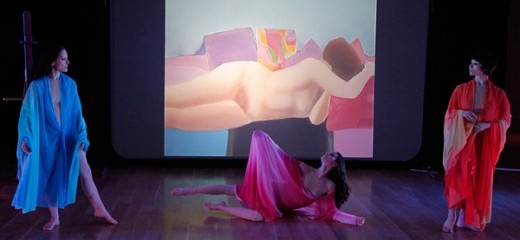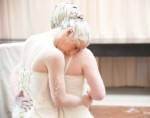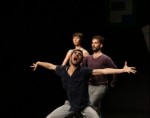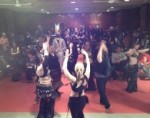
Photo: Bob Emmott
Two Women Walk Out
by Jim Rutter
Instead of finding reasons for gratitude this Thanksgiving, I received two pieces of news for which I’m decidedly unthankful. I learned that a woman for whom I secretly pined chose to become serious with another, and I read in the
Philadelphia Inquirer that Jeanne Ruddy resolved to shutter her eponymous 12-year-old company whose works I had grown to adore.
To me, the two sensations are similar.
According to the Inquirer, Ruddy didn’t disclose why she chose to depart at a time of fiscal and artistic ascendance. The company had run its course and she wanted—perhaps like a lover grown tired—to move forward to new opportunities. Of course, I can’t very much complain, having invested little beyond the involvement of a bystander.
As an audience member, I only knew the pieces from what I saw on stage and can’t claim a more intimate or behind-the-curtain view. Like an imagined, potential love, how the works appeared to me had more to do with my own experiences, personality and imagination than with what Ruddy intended.
But what I already knew of Ruddy’s pieces and her company’s commissioned work had already charmed me.
Ruddy’s Breathless drew on her heritage as a principal dancer with Martha Graham and Graham’s dance theatre traditions. Here, Ruddy depicted the erotically charged murders of three women—Anne-Marie Fahey, Laci Peterson and Philadelphia suburbanite Stefanie Rabinowitz—each killed by a lover and laid to rest in watery graves. Breathless shocked and at times held me rapt with its blend of the sensual and violent. A dancer acted an Aphrodite on a stripper pole, wielding her prop as both a snare and a weapon; later, two of the murderers high-fived after one dragged his girlfriend across the stage by her hair.
In MonTage a Trois, Ruddy transcended storytelling to elevate dancers into works of art. Ruddy set her piece on the Pennsylvania Academy of Fine Art’s galleries. Performers morphed into statues, blended into paintings and shimmered in art nouveau costumes. Janet Pilla and Thayne Dibble contorted against pedestals to create a living frieze, and joined Melissa Chisena in sheer bodysuits to recline like the odalisques seen in slides of Elizabeth Osborne’s paintings. Ruddy’s piece engaged visually and conceptually, raising and exploring questions about how art itself inspires moments of rapture.
Her company also commissioned pieces from top choreographers across the nation, including Ann Reinking, Robert Battle, and Mark Dendy. Ruddy snagged Martha Clarke while the latter still basked in the success of her Broadway remount of Garden of Earthly Delights and brought her to Philadelphia to create the 2009’s nightmarish Sandman. If nothing else, Ruddy employed a steady corps of dancers, and provided one more opportunity to see Pilla—who I consider one of the two best dancers in the city (the second is Tara Keating).
Connecting across a gulf
Most of Ruddy’s pieces invoked theatrical techniques (narrative, characterization, theme—including her own battle against breast cancer) that enhanced her choreography and enabled audiences to connect to even fragments of stories within each piece.
However, in theater as in dance, the proscenium creates an artificial distance—for however much an audience admires a piece; the work speaks from across a gulf. We grow intimate not with the choreographer and dancers, but with our experiences, in what a piece causes us to imagine possible about life, about art, about ourselves. We see without knowing the truth, love blindly without wanting to actually embrace another, and leave the performance with only an imagined, fragmentary, and fractured knowledge of what eluded us in intimacy.
No one says, “I love such-and-such a company…” and means it literally. Those words convey only a cherishment or admiration for the work seen, and a hope—sometimes requited, often not—for a future connection to form. Like unrequited love, that period of time between productions slow-drips across memory like hours spent between glimpses of a lover. In Ruddy’s case, she may have only premiered one new piece a year, and the span between each required a great deal of standing by, filling the time with memories.
Meredith Rainey concretized this in his recent Waiting, one of four pieces on his Carbon Dance Theatre’s program of “Swan Songs.” Each of the evening’s pieces dealt with mortality, and Rainey’s work touched on the death of long stretches of time spent lingering in the purgatory of unrequited love. As two dancers enacted an intricate, emotionally rich duet, another sat on a bench, watching and waiting, yearning for the mere crumbs of affection to fall from the tableside.
It’s too early to tell if Rainey’s Carbon Dance Theatre—with its roots in ballet and storytelling—can replace Ruddy in my artistic affections. For now, I will relish the memories Ruddy gave me, and what she and her works both promised and inspired—that art is worth loving and worth risking one’s love for dance, again and again. And for that, at least, I’m thankful.
Jeanne Ruddy Dance's Spring 2012 Season will be presented May 10-12 at the Suzanne Roberts Theatre. www.ruddydance.org
By Jim Rutter
December 7, 2011









